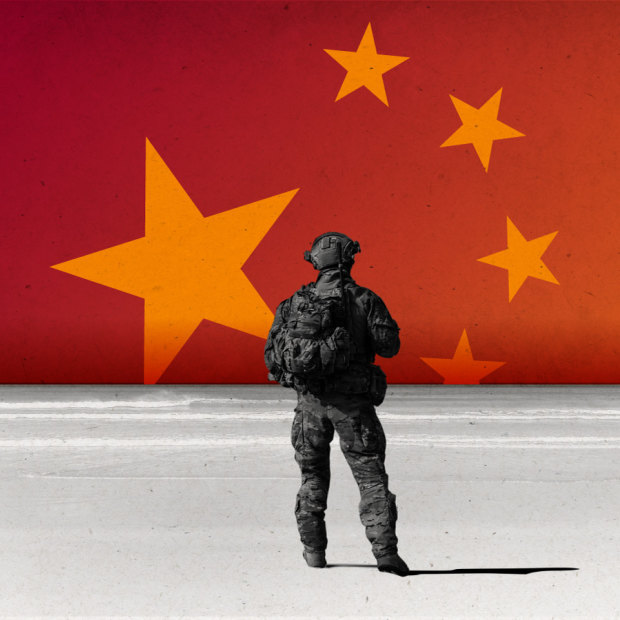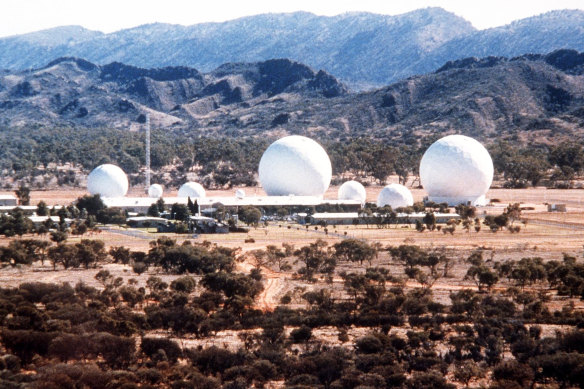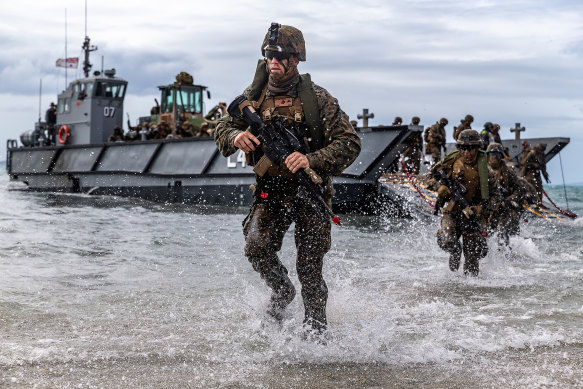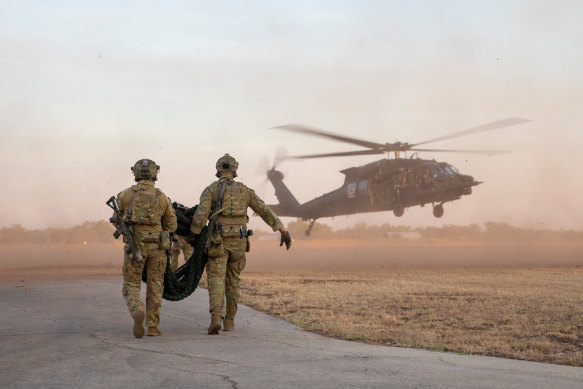This was published 1 year ago
The first 72 hours: How an attack on Taiwan could rapidly reach Australia
A blizzard of cyberattacks from China on Australia’s communications and electricity grid would cripple the nation, our defence panel warns.
By Peter Hartcher and Matthew Knott

Credit:
Within 72 hours of a conflict breaking out over Taiwan, Chinese missile bombardments and devastating cyberattacks would begin pummelling Australia. For the first time since World War II, the mainland would be under attack. Meanwhile, 150,000 American troops would descend on the Top End seeking refuge from the immediate conflict zone.
These are the scenarios Peter Jennings, a former deputy secretary for strategy in the Defence Department, says the nation needs to prepare for.
“As I think of a conflict over Taiwan, what I’m thinking about is something that very quickly grows in scale and location,” says Jennings, who led the Australian Strategic Policy Institute (ASPI) for a decade after leaving the Defence Department. “That matters to Australia. It could very quickly find its way down to our shores.”
While historian Geoffrey Blainey famously argued Australia suffered from the “tyranny of distance”, the nation’s geographical isolation has often been a blessing. The major conflicts of recent years – Afghanistan, Iraq, Ukraine – have taken place in distant lands, allowing Australians to feel secure in their southern sanctuary.
Distance is no longer equivalent to safety
That could all change in a war between China and the US. Five defence experts assembled by The Sydney Morning Herald and The Age for Red Alert, a special review of Australia’s national security, agree such a conflict could break out within three years and would almost certainly involve Australia.
Jennings believes Japan’s strategy in World War II – in which it launched deadly aerial raids on northern Australia to isolate the country from the US – offers a guide for how China may approach a war over Taiwan.
“Distance is no longer equivalent to safety from our strategic perspective,” he says. In the first three days of a war, he says Beijing would be tempted to target Australian military bases with a long-range intercontinental ballistic missile attack to minimise our usefulness in the conflict.
“If China seriously wants to go after Taiwan in a military sense, the only way they can really contemplate quick success is to pre-emptively attack those assets that might be a threat to them. That means Pine Gap goes,” he says, referring to the top secret US-Australian base in the Northern Territory that the US uses to detect nuclear missile launches.
“It means our naval bases go, it means our air bases go very quickly.”
Jennings knows he is breaking a powerful unwritten rule in Australia: don’t mention the war. Critics will accuse him of fearmongering.
“It is a real national taboo to think about the likelihood of a conflict in anything other than the most remotely theoretical perspective,” he says.
He counters that we will sleepwalk into disaster unless we openly discuss unpalatable scenarios.
The Red Alert panellists all agree the ultimate reason for maintaining a well-armed defence force is not to fight wars, but to prevent conflict by deterring would-be attackers.
Lavina Lee, a foreign policy expert at Macquarie University, agrees we need to smash the taboo. She urges Australia to confront “the possibility that we might go to war and what would happen either way. We should talk about what the world would look like if we win and what it would look like if we lose.”
The biggest danger the nation faces is “complacency rather than alarmism”, she says.
Take Australia’s military bases. These facilities – especially those shared with or controlled by the US – are obvious targets for an adversary.
But retired Army major general Mick Ryan says Australians would be scandalised if they knew just how poorly prepared our defence assets were for a potential attack.
“Like most other Western militaries, we believe in the cult of the offensive, so we have underinvested in defensive capabilities,” Ryan says. “Our bases are absolutely undefended.”
Says Jennings: “No Australian defence facilities are protected beyond sort of hired contract guards, and there is no plan to move our own forces quickly in a crisis.”
‘Old, rickety and stuck together with Blu Tack’
Ryan says he would expect China to unleash a blizzard of cyberattacks on our communication systems, and potentially the electricity grid, if a war breaks out. The aim would be to sow confusion, degrade national cohesion and delay decision-making by upending everyday life.
Jennings agrees Chinese cyberattacks on Australian critical infrastructure – electricity and gas distribution, ports, airports, communications networks – would be a logical first step in a conflict. He doubts any of them could withstand a serious attack.
Australia’s critical infrastructure is “old, rickety and is kind of stuck together with Blu Tack,” he says.“It will be thoroughly penetrated by Chinese malware really to shut the place down. The implications of that should remind us just how quickly we will sort of erode from an orderly civilisation.”

Pine Gap, a satellite surveillance base south-west of Alice Springs.Credit: Defence.gov.au
Alan Finkel, Australia’s former chief scientist, warns: “Airlines in particular can be taken down very, very easily. Electricity, probably less so in a sense, because most of our generators are not that sophisticated in terms of cyber. They will be [more sophisticated] five to 10 years from now. Things like the telephone network and airlines are very obvious targets.”
Lesley Seebeck, former head of the Australian National University’s Cyber Institute, says that “the state of our critical infrastructure has just been let lie. There’s no sense of investing for the future.” Once the chief information officer at the Bureau of Meteorology, she says: “I know that from my time at the BOM it was just creaking, it was knitted together, it barely kept up a lot of the time.”
But China’s attacks on Australia would not necessarily be limited to cyber. Ryan says there is a strong agreement among military strategists that a war over Taiwan would “involve strikes on US bases, on fuel and munitions holdings, ships across the region, including our own country potentially”.
Another possibility: China could lay mines to blow up vessels travelling in and out of Australia, a tactic that could devastate the nation by cutting it off from critical supply routes. Ninety per cent of Australia’s fuel is imported and much of it arrives on tankers that transit through the South China Sea – an inevitable hotspot in any war over Taiwan. Australia has only enough fuel on hand to last 61 days, according to the International Energy Agency, the lowest of any member state.
As the panellists write in their joint communique: “Australia has many vulnerabilities. It has long and exposed connections to the rest of the world – sea, air and undersea – yet is incapable of protecting them. So its dependency on imports of essentials – including fuel, pharmaceuticals, electronics and weaponry – could be a fatal weakness in a crisis. This was exposed in World War II yet remains unaddressed.”
‘Get out of Guam’
But why would China use its limited resources to attack Australia instead of focusing solely on seizing Taiwan? Because of the strategically crucial role Australia is expected to play for the United States in the conflict.
“Our geography means we are a southern base for the Americans for what comes next,” Ryan says. “That’s how they’re seeing us. They want our geography. They want us to build bases for several hundred thousand Americans in due course like in World War II.”
Jennings says Americans would defend Taiwan by fighting from bases in Australia.
“America has a strategy called dispersal, which means when there’s a hint of a crisis, the Air Force gets out of Guam, the marines get out of Okinawa. Why? Because they know there is a high chance they will be obliterated. Where do they come? They come here. One risk our government is very concerned about is the phone rings, and it’s the US President asking for 150,000 Americans to be in the Northern Territory by next Tuesday.”
Ryan says as many as 200,000 US troops could descend on northern Australia.

U.S. Marines conduct a simulated amphibious assault of exercise Talisman Sabre 19 in Bowen, Australia.Credit: Lance Cpl. Tanner D. Lambert
“The big challenge,” he says, “is how do we develop the infrastructure for that many people arriving that quickly. Because it doesn’t exist at the moment. It’s going to be a massive national challenge.”
‘Defensive posture and absorbing punishment’
The Australian Defence Force (ADF) also lacks the capacity to strike back if it comes under attack from a foreign power. “I think the most depressing thing about the ADF now is that for $46-$47 billion a year, we get very little high explosive on target,” Jennings says.
A report released last year by ASPI on the nation’s long-range strike capacities detailed the problem bluntly. “Currently, the ADF doesn’t have a strike system that can pose a credible deterrent,” wrote defence experts Marcus Hellyer and Andrew Nicholls. “Arguably, the ADF currently has no long-range land-strike capability.”
This has dire implications for a potential war with China. “Without striking range, we’re simply adopting a defensive posture and absorbing punishment,” they warn.
Lee says now is the time to address issues we’d rather ignore. “Do we have the capabilities now to make a sufficient contribution to US force protection in the region? Will we have sufficient long-range strike capabilities to keep our adversaries at bay when we need it? And what sacrifices might need to be made domestically now, in order to deter China from using force to seize Taiwan in the first place?”
No-one can know for certain how a future war, including over Taiwan, will play out. But it’s the job of the nation’s policymakers to plan for dire scenarios as well as desirable ones.
Of the three branches of the military, Jennings argues only the Royal Australian Air Force is up to scratch. The Navy, he says, is a “generation-and-a-half behind where it should be”, and the Army is struggling to define its purpose.
As proof, he points to last May’s budget, where the Morrison government scrapped plans to buy the MQ-9 Reaper, an armed drone the US Air Force says has a unique capability to perform strike missions, gather information, and track high-value targets. Drones have played a crucial role in recent wars, such as Afghanistan and Ukraine, yet Australia has shunned them until now.
“That was nuts,” Jennings says of the decision to reallocate the money to the Australian Signals Directorate. “We are the only front-rank military in the world not to have an armed drone in service.”
Mick Ryan faults the ADF with being too focused on acquiring “big, heavy, expensive manned platforms” – think frigates, submarines, aerial bombers – and ignoring cheaper unmanned systems like drones and autonomous vehicles. “The ADF has been extraordinarily resistant to autonomous systems,” he says. “We’re a long way behind the rest of the world and there are lots of Australian companies that can do this.“
‘A large power acting like a middling one’
The panellists stress that Australia’s vulnerabilities are not only physical, but psychological. “Why do we keep calling ourselves a middle power?” asks an exasperated Lee. “What we do matters. We might not be able to change China’s objectives, but we can alter its cost calculations and behaviour and constrain its options. In this sense, the danger is complacency rather than alarmism.”

RAAF Base Tindal, Northern Territory.Credit: Pfc. Matthew Mackintosh / Department of Defence
According to the Lowy Institute, Australia is already more powerful in the Asia-Pacific than more populous nations, such as Indonesia and South Korea. Soon we could vault over Russia to become the fifth most powerful country in the region. Yet we still think of ourselves as a geopolitical bit player punching above our weight.
“We are actually a large power that acts like a middling one,” says Ryan. “For me the threat is that as a country, we still have a cultural cringe when it comes to strategic thinking. We still defer to Big Brother as we were taught to do as a colony. We like copying the Americans. What it means is we haven’t developed our own ability to conduct critical strategic thinking across a range of different institutions to address complex problems.”
Seebeck – who has spent most of her life in the national capital as an academic, public servant and consultant – says: “Canberra is the worst place in the world to do some of this stuff from. It’s isolated, it’s middle class, it’s fat, dumb and happy. It’s self-referential.”
Finkel, a successful entrepreneur before he became a go-to government adviser, cautions against too much criticism of Australia. The nation has world-class universities, a strong economy and a strong democracy. The problem, he says, is “we don’t do things quickly. And whatever threats are coming, they’re not, with great respect to everyone here, going to be exactly as planned. We need the ability to react to the unknowns… What works during peacetime isn’t going to be appropriate for conflict.”
Passing the Zelensky test
So, are our nation’s leaders up to it? Jennings is dubious. “I have no faith that as a group of people we have the capacity to gear ourselves to deal with the high-level threat environment that we’re talking about here,” he says.
Pointing to the ADF’s repeated failures to invest in the right military equipment to protect the nation, he says: “We need to get to a point where we can say it’s all broken, and we have to rethink it, probably with a whole different bunch of people to do it for us.”
As a veteran defence policy insider, he includes himself on the list of the culpable.
Ryan says the coming years will require a fundamentally different, less risk- averse style of leadership from Australia’s decision-makers.
“How many Australian leaders would pass the ‘Zelensky test’?” he asks, referring to Ukraine’s President Volodymyr Zelensky. “How many could get out there and say, ‘I don’t need a ride, I need ammunition’ and put themselves and the government at risk to make the right decisions, not the one that’s well tested in the polls? … We’re going to have to make decisions about risk and leadership and creativity and strategy that we haven’t been capable of making since World War II.”
It didn’t always appear obvious that Zelensky – a former comedian who played a fictional president on television – would himself pass the test until Russia invaded his country.
You only know what people are made of when they are tested by a crisis, and that moment could arrive far sooner than we’d like.
Tomorrow: The taboos we must confront to defend Australia
Cut through the noise of federal politics with news, views and expert analysis from Jacqueline Maley. Subscribers can sign up to our weekly Inside Politics newsletter here.